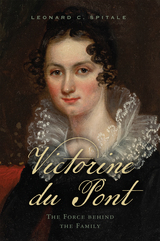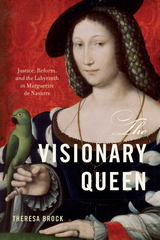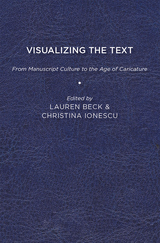106 scholarly books by University of Delaware Press and 4
start with V
106 scholarly books by University of Delaware Press and 4
106 scholarly books by University of Delaware Press
4 start with V start with V
4 start with V start with V

Victorine du Pont
The Force behind the Family
Leonard C. Spitale
University of Delaware Press, 2023
Victorine Elizabeth du Pont, the first child of Eleuthère Irénée du Pont and his wife Sophie, was seven years old when her family emigrated to America, where her father established the humble beginnings of what would become a corporate giant. Through correspondence with friends and relatives from the ages of eight to sixty-eight, Victorine unwittingly chronicled the first sixty years of the du Pont saga in America. As she recovered from personal tragedy, she became first tutor of her siblings and relations. This biography makes the case that Victorine has had the broadest—and most enduring—influence within the entire du Pont family of any family member. The intellectual heir of her venerable grandfather, Pierre Samuel du Pont de Nemours, although Victorine grew up in an age where women's opportunities were limited, her pioneering efforts in education, medicine, and religion transformed an entire millworkers’ community.
[more]

The Visionary Queen
Justice, Reform, and the Labyrinth in Marguerite de Navarre
Theresa Brock
University of Delaware Press, 2024
The Visionary Queen affirms Marguerite de Navarre’s status not only as a political figure, author, or proponent of nonschismatic reform but also as a visionary. In her life and writings, the queen of Navarre dissected the injustices that her society and its institutions perpetuated against women. We also see evidence that she used her literary texts, especially the Heptaméron, as an exploratory space in which to generate a creative vision for institutional reform. The Heptaméron’s approach to reform emerges from statistical analysis of the text’s seventy-two tales, which reveals new insights into trends within the work, including the different categories of wrongdoing by male, institutional representatives from the Church and aristocracy, as well as the varying responses to injustice that characters in the tales employ as they pursue reform. Throughout its chapters, The Visionary Queen foregrounds the trope of the labyrinth, a potent symbol in early modern Europe that encapsulated both the fallen world and redemption, two themes that underlie Marguerite's project of reform.
[more]

Visualizing the Text
From Manuscript Culture to the Age of Caricature
Lauren Beck
University of Delaware Press, 2017
This volume presents in-depth and contextualized analyses of a wealth of visual materials. These documents provide viewers with a mesmerizing and informative glimpse into how the early modern world was interpreted by image-makers and presented to viewers during a period that spans from manuscript culture to the age of caricature. The premise of this collection responds to a fundamental question: how are early modern texts, objects, and systems of knowledge imaged and consumed through bimodal, hybrid, or intermedial products that rely on both words and pictures to convey meaning? The twelve contributors to this collection go beyond traditional lines of inquiry into word-and-image interaction to deconstruct visual dynamics and politics—to show how images were shaped, manipulated, displayed, and distributed to represent the material world, to propagate official and commercial messages, to support religious practice and ideology, or to embody relations of power. These chapters are anchored in various theoretical and disciplinary points of departure, such as the history of collections and collecting, literary theory and criticism, the histories of science, art history and visual culture, word-and-image studies, as well as print culture and book illustration. Authors draw upon a wide range of visual material hitherto insufficiently explored and placed in context, in some cases hidden in museums and archives, or previously assessed only from a disciplinary standpoint that favored either the image or the text but not both in relation to each other. They include manuscript illuminations representing compilers and collections, frontispieces and other accompanying plates published in catalogues and museographies, astronomical diagrams, mixed pictographic-alphabetic accounting documents, Spanish baroque paintings, illustrative frontispieces or series inspired by or designed for single novels or anthologies, anatomical drawings featured in encyclopedic publications, visual patterns of volcanic formations, engravings representing the New World that accompany non-fictional travelogues, commonplace books that interlace text and images, and graphic satire. Geographically, the collection covers imperial centers (Great Britain, France, the Netherlands, and Spain), as well as their colonial periphery (New France; Mexico; Central America; South America, in particular Brazil; parts of Africa; and the island of Ceylon). Emblematic and thought-provoking, these images are only fragments of the multifaceted and comprehensive visual mosaic created during the early modern period, but their consideration has far reaching implications.
[more]

Votes for Delaware Women
Anne M. Boylan
University of Delaware Press, 2021
Votes for Delaware Women is the first book-length study of the woman suffrage struggle in Delaware, placing it within the rich historical scholarship of the national story. It looks especially at why, despite decades of suffrage organizing and an epic struggle in Dover, in the spring of 1920, the legislature refused to make Delaware the final state to ratify the Nineteenth Amendment. The book traces how, starting in the 1890s, white and African American women organized and advocated for "votes for women," first by revising the state constitution and then through a federal amendment. Within the state's two major suffrage organizations, the Delaware Equal Suffrage Association (DESA), an affiliate of the National American Women Suffrage Association (NAWSA), and the Delaware branch of the National Woman's Party (NWP), divisions over strategy and tactics widened into fissures, especially during the Great War, making it difficult to unite in a common endeavor. Delaware was unusual as a border state that was segregated but did not disfranchise African Americans. In the end, the book argues, a combination of racial and class issues doomed the ratification effort.
[more]
READERS
Browse our collection.
PUBLISHERS
See BiblioVault's publisher services.
STUDENT SERVICES
Files for college accessibility offices.
UChicago Accessibility Resources
home | accessibility | search | about | contact us
BiblioVault ® 2001 - 2024
The University of Chicago Press









